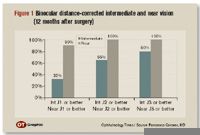Article
Presbyopes seeking spectacle independence might consider apodized diffractive IOL
Las Vegas-Refractive lens exchange (RLE) with a multifocal IOL is the refractive surgery procedure of choice for the presbyopic patient, said Francesco Carones, MD, at the refractive surgery subspecialty day during the American Academy of Ophthalmology annual meeting.

"This technique can correct even higher levels of myopia and hyperopia and has many advantages because it provides immediate, stable results; a high likelihood of spectacle independence; and excellent safety. Furthermore, it can be considered ultimate surgery when performed in eyes with clear lenses because it eliminates the possibility of future cataract development," said Dr. Carones, medical director, Carones Ophthalmology Center, Milan, Italy.
"However, maximizing patient satisfaction and vision outcomes depends on achieving a perfect refractive result. Therefore, the surgeon must pay careful attention to the preoperative evaluation, use an appropriate customized formula for accurate IOL power calculation, and perform surgery that is astigmatically neutral or targeted to reduce existing astigmatism," Dr. Carones said. "Still, patients must also be informed preoperatively that laser vision correction may be needed to fine-tune the results."
"The . . . IOL incorporates the concepts of diffraction-refraction to gain the advantages of both technologies and is very pupil friendly with respect to vision," he explained. "The optic features a +3.2-D add for reading correction, so near vision quality is excellent, and this . . . implant affords better intermediate vision than zonal refractive IOLs and full optic diffractive IOLs while being less associated with haloes and night-vision problems than those technologies. By providing a full range of good uncorrected vision, the . . . lens is associated with high rates of spectacle independence, and that makes it very suitable for the patient undergoing RLE who is primarily motivated to eliminate spectacle wear."
The 40 patients in his series included 31 patients with hyperopia (spherical equivalent [SE] +1.25 to +7.50 D) and nine myopic patients (SE –1.25 to –14.50 D). The patients ranged in age from 41 to 71 years, all eyes had clear lenses, and all patients were highly motivated to eliminate spectacle wear.

Residual refractive correction
Patients with residual spherical or astigmatic error were offered LASIK 2 months post-RLE; 23 eyes (28.8%) underwent an enhancement procedure. Residual sphere in those eyes ranged from –3.75 to +1.50 D, and residual cylinder was between 0.50 and 2.75 D.
"That is a relatively high enhancement rate, but in 15 cases, the LASIK procedure was planned at the time of the RLE surgery to correct pre-existing astigmatism or correct residual sphere because the necessary IOL power to achieve emmetropia was not available. Even so, the 8% rate of unpredicted enhancements is relatively high," Dr. Carones said.




